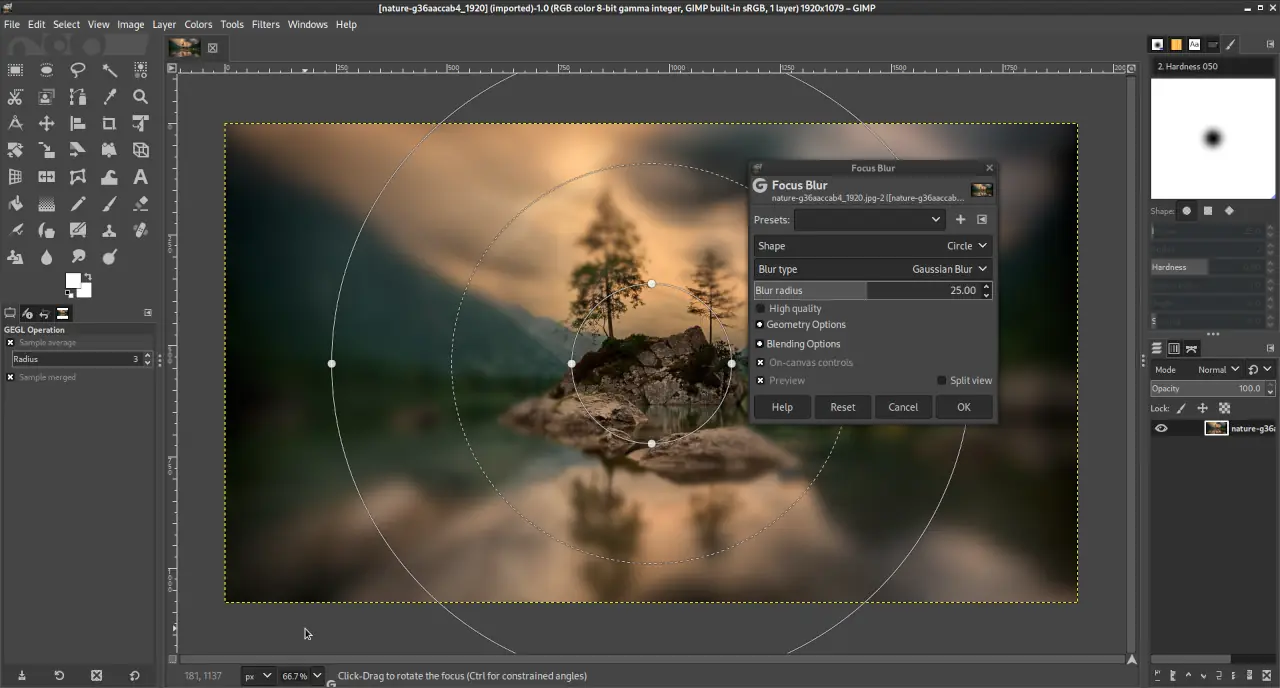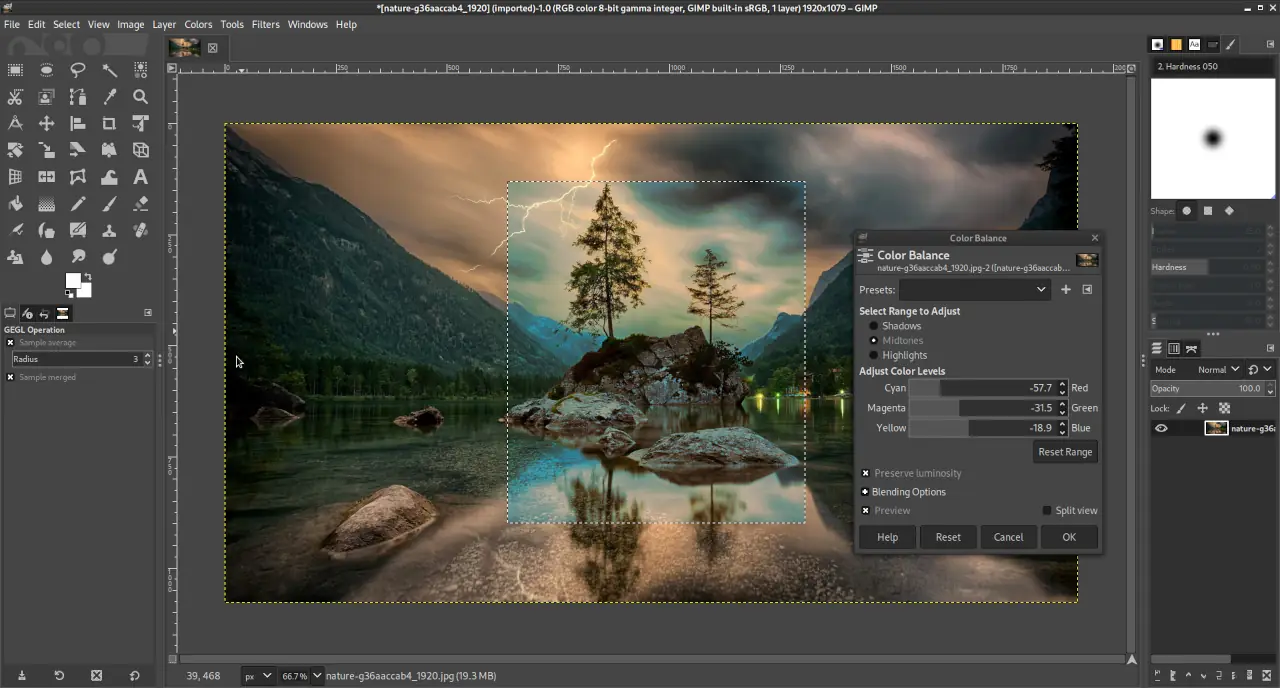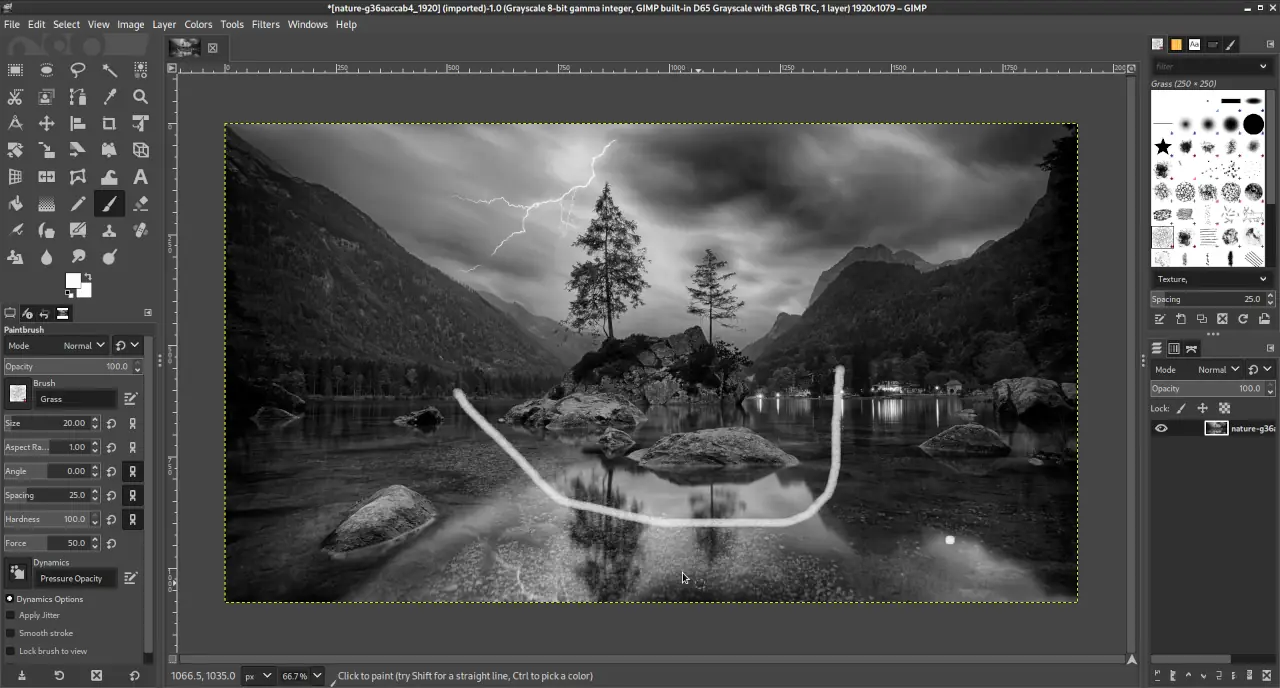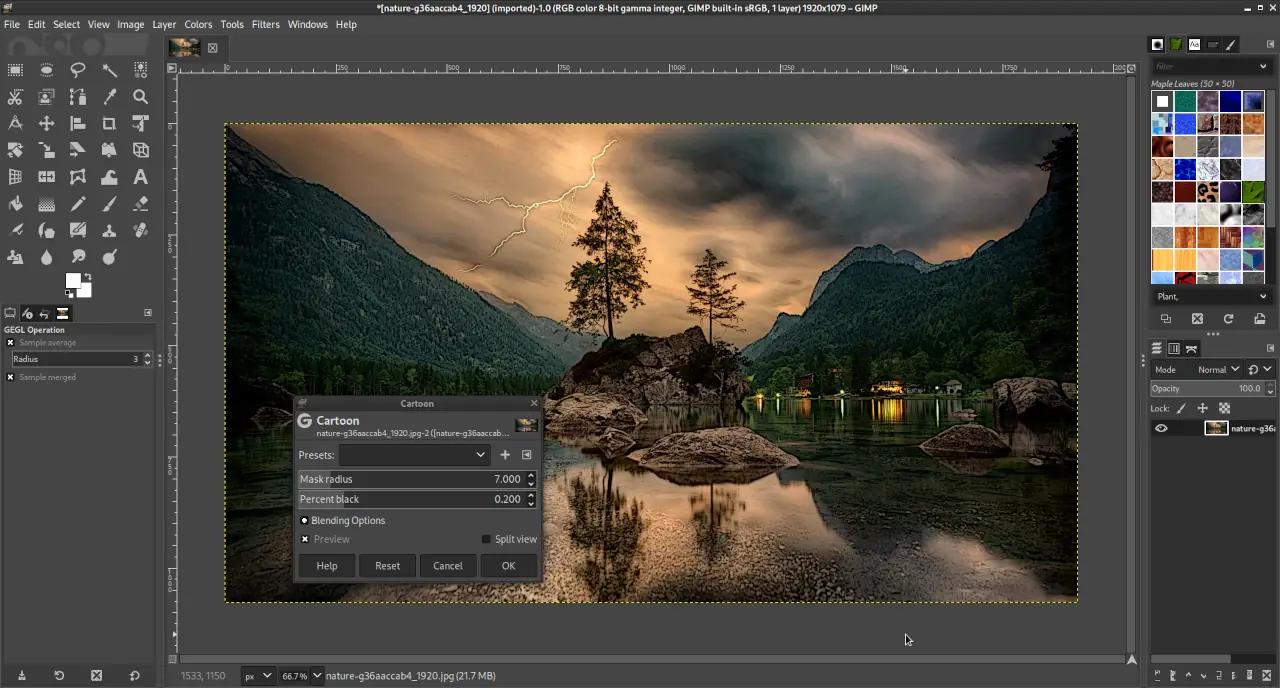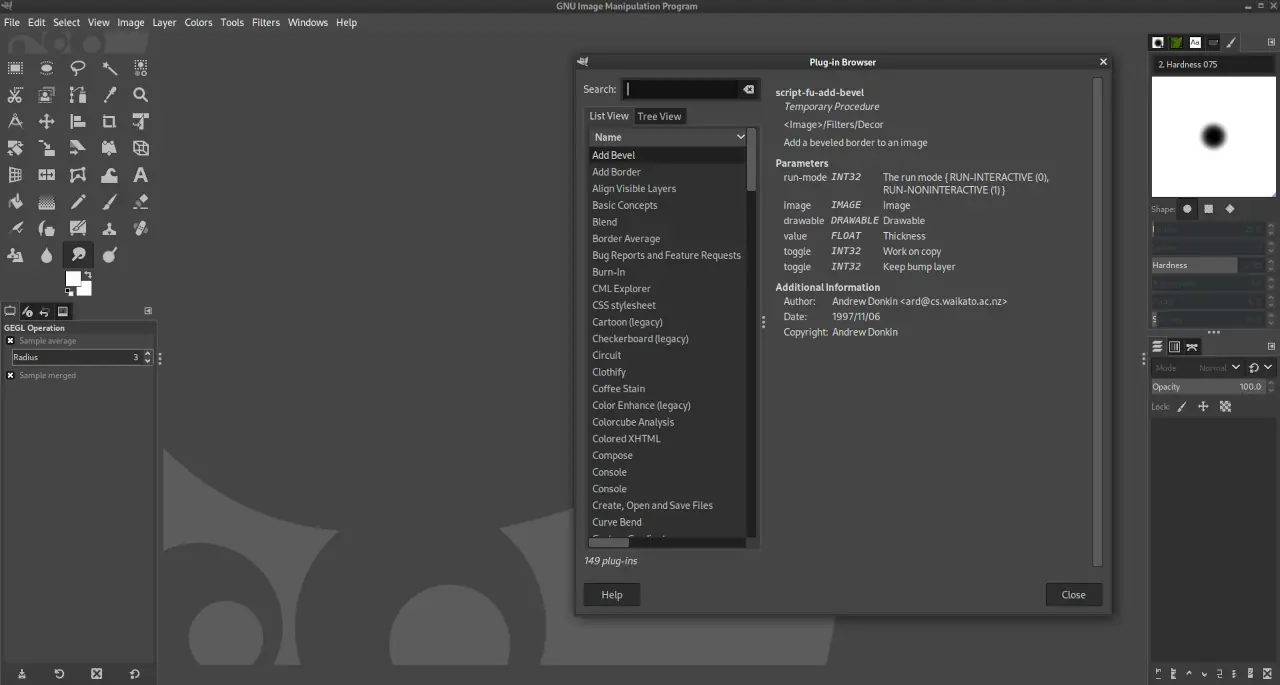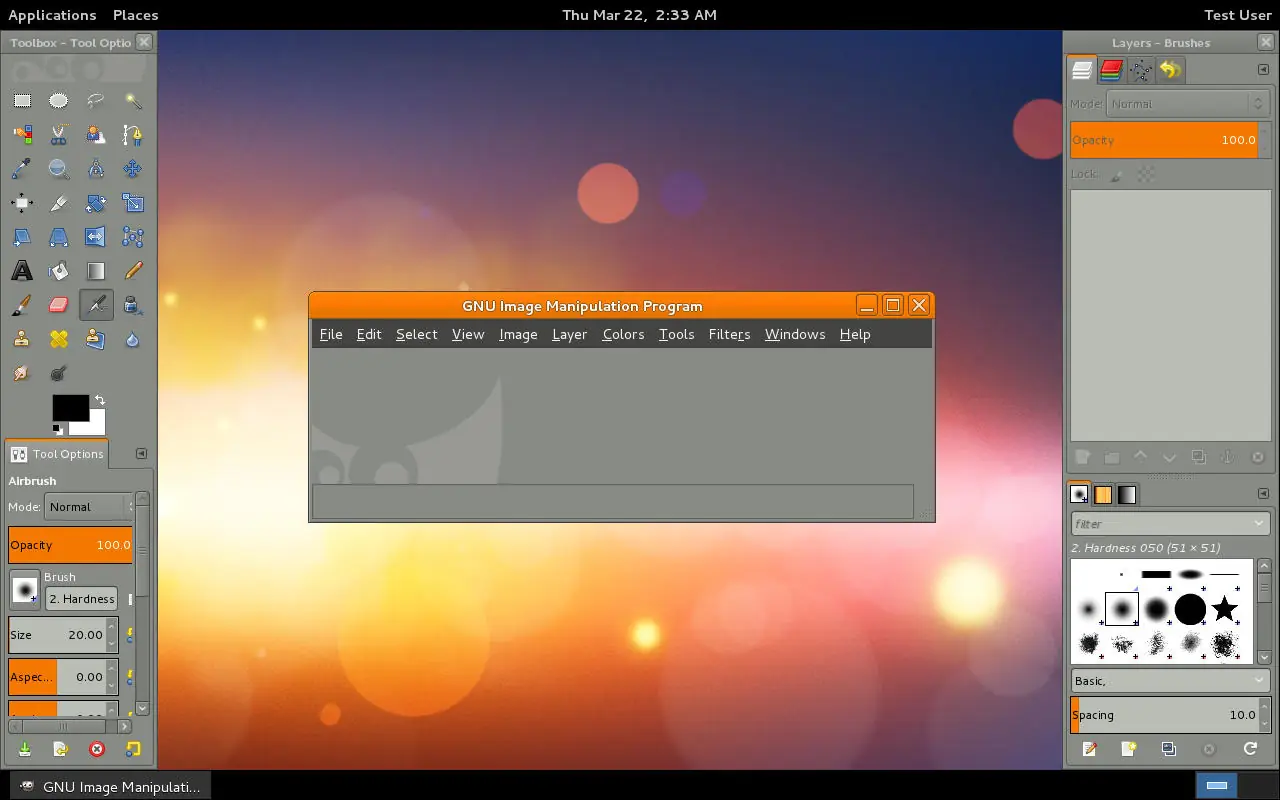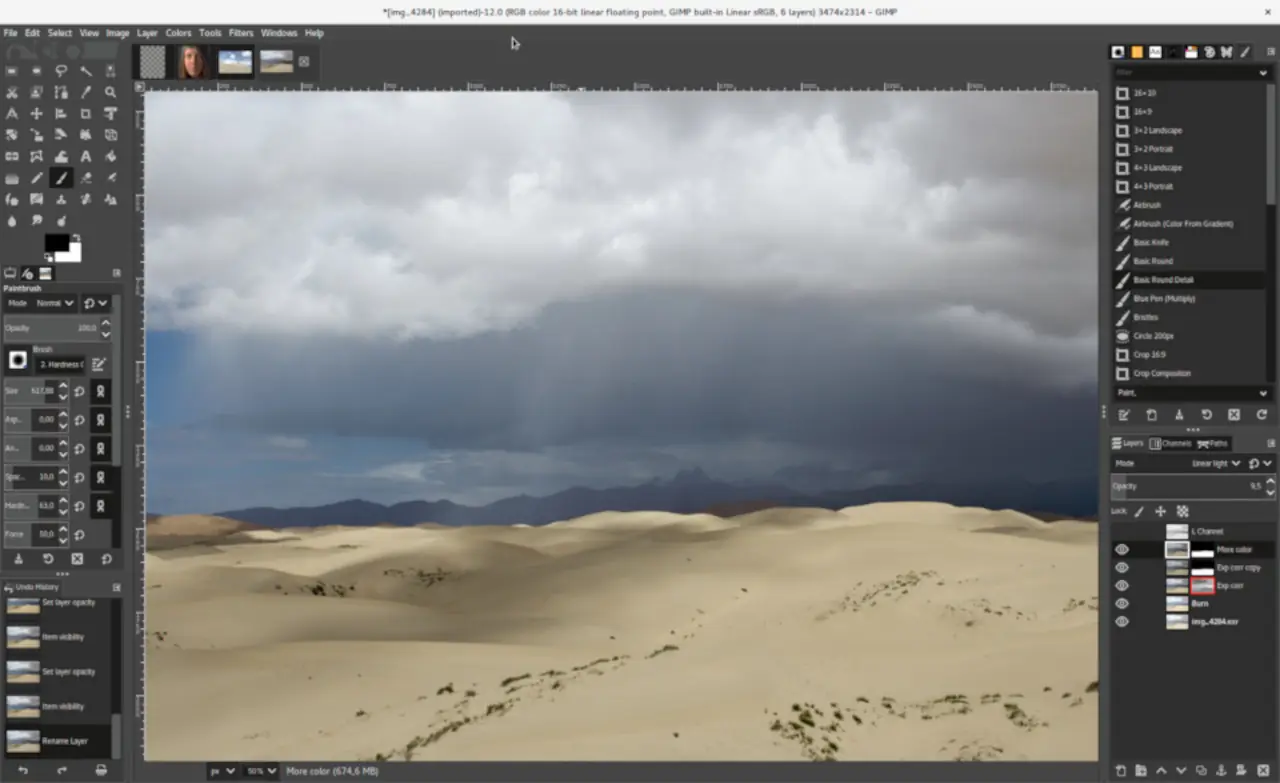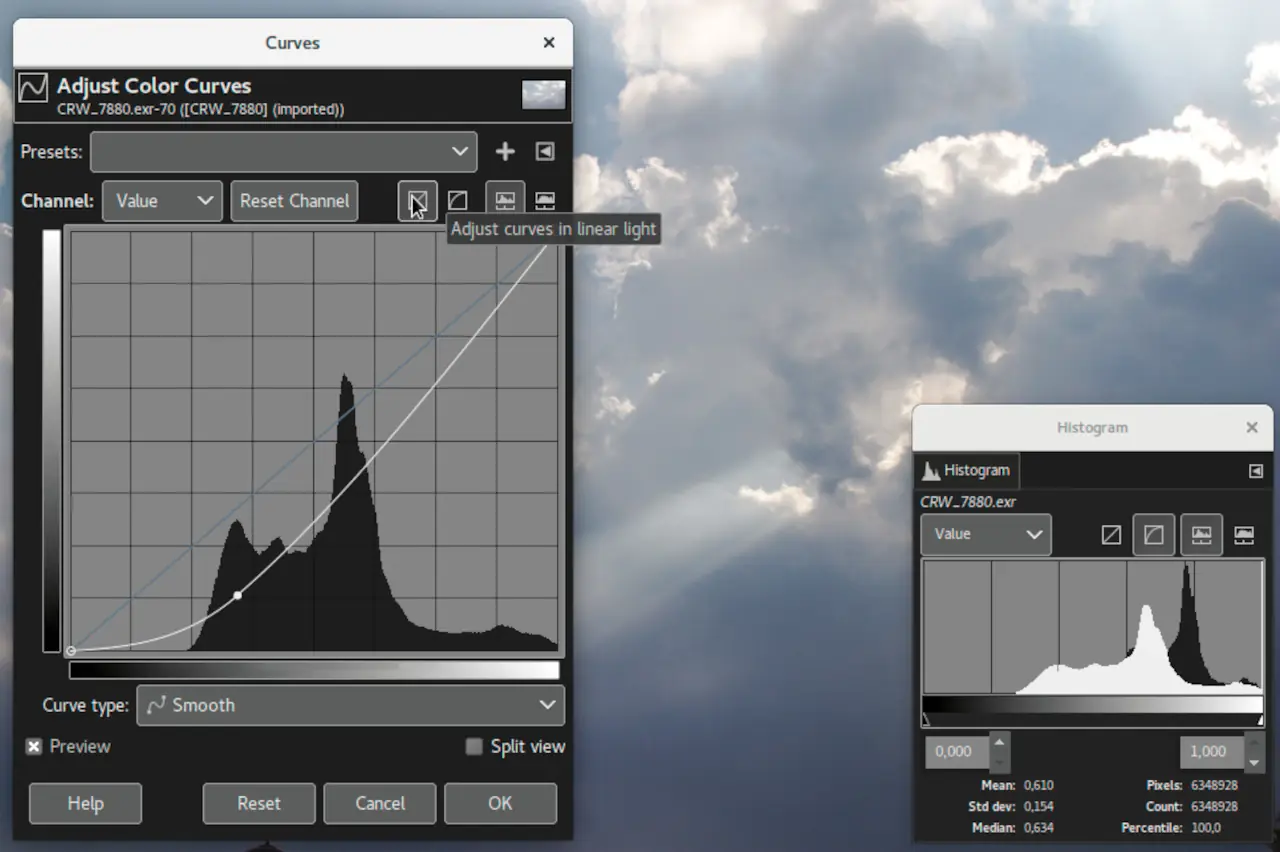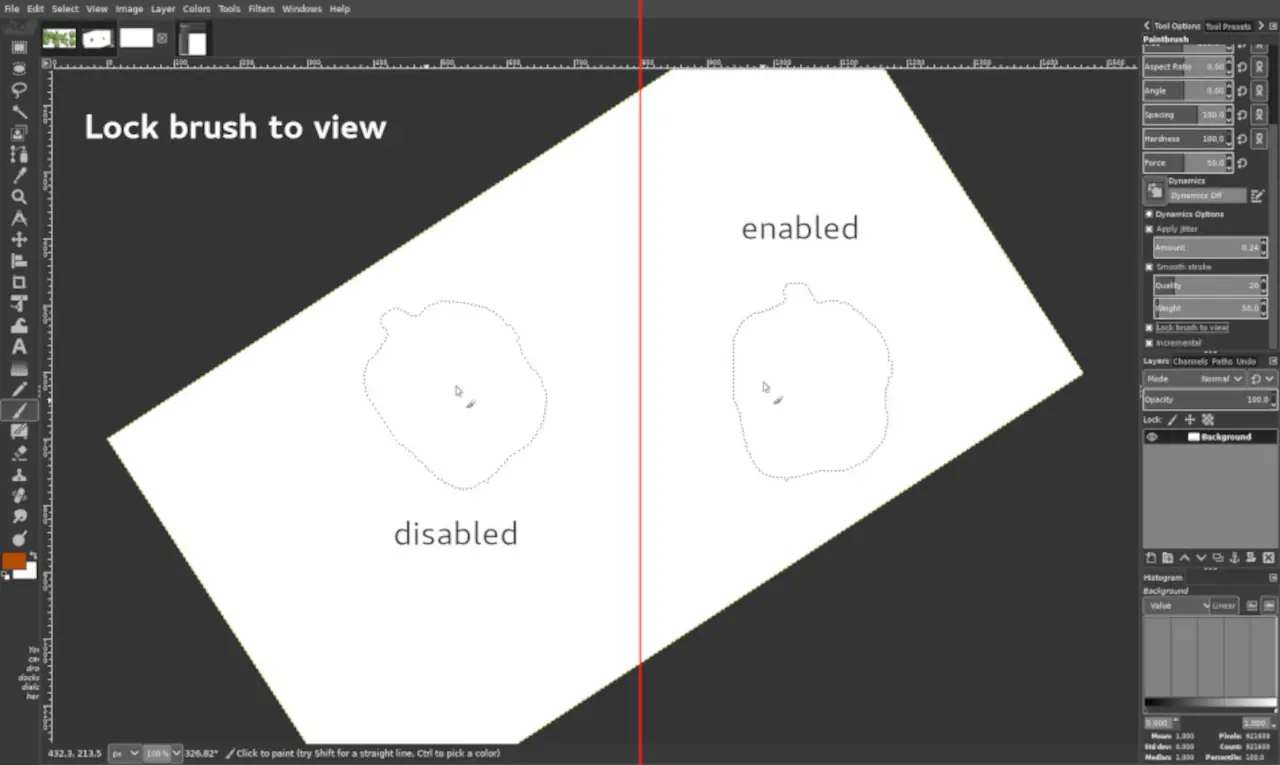4.42
GIMP - GNU Image Manipulation Program: a free and open-source image and photo editor
Cross-platform image editor available for many operating systems. It is free software, you can change its source code and distribute your changes. GIMP can be used for photo retouching, image composition and image authoring.
Category: software, open source, free, graphics, photo editor
Stable Version: GIMP 2.10.34
Release Date: 2023-02-10
Runs on: windows, mac, linux, openbsd, netbsd, freebsd, bsd, solaris








Download
GIMP/ Install Binaries: Links on the Official Website
Disclaimer: We do not store any binary or executable file formats on this website to provide direct file downloads. All download links of binaries or executables presented on this website, for any software application without exception, are provided only from the application's publisher Official Website and no other locations. This website is not responsible for the accuracy or safety of the software applications presented here. In particular this website section is just a catalog with popular opensource software applications mainly addressed to software developers to easy the access to the open source code.
Get the Source Code of
GIMP/ Software Source Code Download
Specifications:
- Project Developer:
GIMP Development Team
- License: GNU General Public License (GPL) v3
- OpenSource, Free: Yes
- Written in:
C
Building from Source: dependencies
- Intltool, ISO Codes, Harfbuzz, FreeType2
- Glib2, Glib2 Networking, Appstream Glib
- Pango, Cairo, GTK+3, GTK+2 (req. by some plugins), GDK Pifbuf
- Python, Python GTk2 (req. by some plugins)
- Zlib, Lzip Lib, Bzip2, Xz, LZMA
- Jasper, MyPaint Brushes, LibMyPaint
- Poppler, Poppler Data, CUPS
- AaLib, Babl, Gegl
- LibRSvg, Jpeg, Jbig2dec, Png, Tiff, LibHeif, LibWebP, LibWmf
- GNU Ghostscript, LCMS2, LibGexiv2, LibMng, OpenExr
- LLVM or GCC compiler
Review
0
5
4.8
w3soft.org
GIMP (GNU Image Manipulation Program) is a free and open-source raster graphics editor used for image manipulation - (retouching) and image editing, free-form drawing, transcoding between different image file formats, and more specialized tasks. It is not designed to be used for drawing, though some artists and creators have used it for such purposes. Whether you are a graphic designer, photographer, illustrator, or scientist, it provides you with sophisticated tools to get your job done. You can further enhance your productivity with GIMP thanks to many customization options and 3rd party plugins.
This editor has many capabilities. It can be used as a simple paint program, an expert quality photo retouching program, a tool to create digital art, an online batch processing system, a mass production image renderer, an image format converter, etc.
It is expandable and extensible. It is designed to be augmented with plug-ins and extensions to do just about anything. The advanced scripting interface allows everything from the simplest task to the most complex image manipulation procedures to be easily scripted.
Pros +
- tools are now grouped in the toolbox by default
- sliders now use a compact style with improved user interaction
- vastly improved user experience for the transformation preview
- dockable areas now highlighted when a dockable dialog is being dragged
- new 3D transform tool to rotate and pan items
- much smoother brush outline preview motion on the canvas
- symmetry painting enhancements
- faster loading of ABR brushes: it spends a lot less time loading Photoshop's brushes (ABR)
- support improvements: Photoshop PSD files now load faster mostly by eliminating excessive copies between the original file and the project representation inside this graphic editor ; for large PSD files, the loading is now ~1.5x to ~2x times faster
- it is now capable of loading CMYK(A) PSD files (only 8-bit per channel for now)
- consolidated user interface for merging down and anchoring layers
- supports the full alpha channel
- it provides transformable selections and paths
- easy to use gradient editor and blend tool
- require a small amount of memory compared with other similar tools
Cons -
- the CMYK color model support is limited: Separate+ and its predecessors have no support for GCR (Grey Component Replacement) and UCR (Undercolor Removal)
- creating good looking arc shape may be a bit difficult
- it contains limited third-party plugins and is expected in the future to provide a wider variety of plugins
About
GIMP is a multi-platform tool to create and edit images of all kinds. It is an acronym for GNU Image Manipulation Program. This software is a free and open-source replacement for Adobe Photoshop and is available for a variety of operating systems.
Features
Overview
- offers a full suite of painting tools including brushes, a pencil, an airbrush, cloning, etc.
- tile-based memory management, so image size is limited only by available disk space
- sub-pixel sampling for all paint tools for high-quality anti-aliasing
- full Alpha channel support for working with transparency
- layers and channels
- a procedural database for calling internal functions from external programs, such as Script-Fu
- advanced scripting capabilities
- multiple undo/redo (limited only by disk space)
- transformation tools including rotate, scale, shear and flip
- it has basic vector graphic features, can import SVG vector files
- support for a wide range of file formats, including WEBP, HEIF, JPEG, PNG, GIF, PSD, DDS, XPM, TIFF, TGA, MPEG, PS, PDF, PCX, BMP and many others
- selection tools, including rectangle, ellipse, free, fuzzy, bezier and intelligent scissors
- plug-ins that allow for the easy addition of new file formats and new effect filters
Tools and plugins available as default
- Selections tools: square region, eclipse, lasso, scissors, foreground, fuzzy, etc.
- Brush tools: Blend, paintbrush, airbrush, clone, heal, and more, pencil, smudge, dodge, ink, perspective clone, and bucket fill
- Transform tools: Move, crop, rotate, scale, flip, scale, align, and perspective
- Colour tools: Color balance, colourize, brightness-contrast, threshold, posterize, desaturate, threshold, levels, curves, brightness-contrast tool, hue-saturation, etc.
- Other tools: Path, measure, magnify, and color picker tool
Popular 3rd party plugins available
- the deskew plug-in
- lensfun: plugin for correcting lens distortion
- liquid-rescale: seam-carving smart rescale plugin
- resynthesizer: a plugin for image reparation
Screenshot: Main Screen
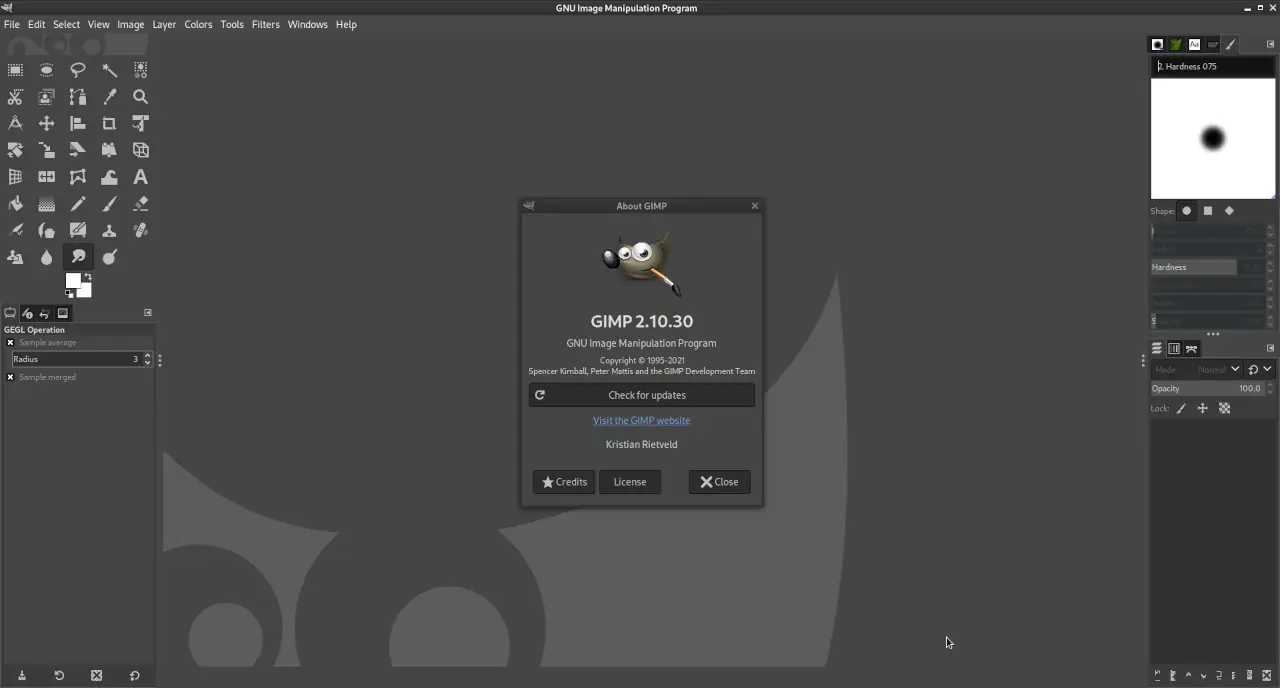
Changelog Highlights
2023-02-10 : version 2.10.34
notable changes
- update some translations
- stability, bugs and performance fixes
- fix documentation
2022-06-14 : version 2.10.32
notable changes
- a bug fix release for the 2.10 branch
- add support for 8 and 16-bit CMYK(A) TIFF files on import ; BigTIFF format is now supported
- add support for JPEG XL file format has been supported
- XCF import code also received various improvements, making the software more robust to invalid files
2018-11-08 : version 2.10
notable changes
- It is the result of six years of work that originally focused on porting the program to a new image processing engine, GEGL
- Updated user interface and initial HiDPI support ; new dark theme and symbolic icons enabled by default ; icons are available in four sizes now, so that GIMP would look better on HiDPI displays
- GEGL port, high bit depth support, multi-threading, and more ; now GIMP uses GEGL for all tile management and builds an acyclic graph for every project
- High bit depth support allows processing images with up to 32-bit per color channel precision and open/export PSD, TIFF, PNG, EXR, and RGBE files in their native fidelity ; additionally, FITS images can be opened with up to 64-bit per channel precision
- Multi-threading allows making use of multiple cores for processing ; not all features in GIMP make use of that yet
- Linear color space workflow - Another benefit of using GEGL is being able to work on images in a linear RGB color space as opposed to gamma-corrected (perceptual) RGB color space
- Color management revamped - Color management is now a core feature of GIMP rather than a plug-in ; this made it possible, in particular, to introduce color management to all custom widgets we could think of image previews, color and pattern previews etc
- GIMP now uses LittleCMS v2, which allows it to use ICC v4 color profiles
- Layers and masks - GIMP now ships with two groups of blending modes - legacy (perceptual, mostly to make old XCF files look exactly as before) and default (mostly linear)
- More use for CIE LAB and CIE LCH - introduced a number of features that make use of CIE LAB and CIE LCH color spaces
- New Unified Transform tool simplifies making multiple transforms, such as scaling, rotating, and correcting perspective in one go
- The new Warp Transform tool allows doing localized transforms like growing or shifting pixels with a soft brush and undo support
- Blend tool becomes Gradient tool and gets on-canvas editing ; renamed the Blend tool to Gradient tool and changed its default shortcut to G
- Better selection tools - the Foreground Select tool can finally make subpixel selections in complex cases such as strays of hair on textured background
- Text tool supports CJK and more writing systems
- Experimental tools - Seamless Clone tool and N-Point Deformation tool
- Digital photography improvements - Some of the new GEGL-based filters are specifically targeted at photographers - Exposure, Shadows-Highlights, High-pass, Wavelet Decompose, Panorama Projection
- Plug-ins - GIMP now ships with over 80 GEGL-based filters ; a lot of those are former GIMP effects
- Usability improvements - all transformation tools now automatically disable original layer view
- File formats support - GIMP is now capable of reading and writing TIFF, PNG, PSD, and FITS files with up to 32-bit per channel precision where applicable
- Metadata viewing, editing, and preservation - GIMP now ships with plug-ins for viewing and editing Exif, XMP, IPTC, GPS, and DICOM metadata
- On-canvas interaction - a new feature that allows some GEGL-based filters to render on-canvas controls
- Search system - GIMP keeps growing and getting more features, it becomes increasingly difficult to locate this or that command in the user interface
- API changes - deprecated a lot of API, providing a compatibility layer for 3rd party developers who write scripts and plug-ins
- Add native support for HEIF/HEIC and WEBP
2012-05-03 : version 2.8
notable changes
- Single-Window Mode - You can toggle between the default multi-window mode and the new single-window mode
- Multi-Column Dock Windows - allows dockable dialogs in a dock window to be placed in multiple columns
- docking bars have been removed and replaced with overlaid highlights
- Saving an image can only be done in the XCF format which is GIMP’s native file format, able to save all kinds of information necessary for works in progress ; Saving an image can only be done in the XCF format which is GIMP’s native file format, able to save all kinds of information necessary for works in progress
- Lets you users organize their compositions better through the introduction of layer groups which allow layers to be organized in tree-like structures
- All tools rendering on canvas have been ported to Cairo to provide smooth antialiased graphics and make GIMP’s look and feel match modern users expectations
- Text editing with the Text Tool is now performed on-canvas instead of in a separate window
- Since the keyboard shortcuts Ctrl+E and Ctrl+Shift+E have been repurposed for the image export mechanisms, new keyboard shortcuts have been setup for 'Shrink Wrap' and 'Fit in Window', namely Ctrl+J and Ctrl+Shift+J respectively
- The brush dynamics engine has been expanded considerably, making almost all aspects of the brush engine drivable by a multitude of inputs, all of them configurable with their own response curve
- You can now save existing state of any tool as a preset and give it a meaningful name
- A plug-in for loading JPEG2000 images has been added, as well as plug-ins for X11 Mouse Cursor files and fundamental OpenRaster (.ora) import and export support ; added RGB565 support to the csource plug-in
- A new experimental widget was added to meet the requirements of graphic tablets users ; the widget combines a slider, a label and a numeric value control which simplifies adjusting a value using a stylus, better visualizes the current value and provides a more compact UI
- It is now possible to tag GIMP resources such as brushes and patterns to group them ; the tagging is performed from the respective dockables e.g. the Brushes dockable, and it is possible to filter resources based on these tags
- A lot of GIMP APIs have been refactored to simplify developing new scripts
- The projection code which composes a single image from layers has been ported to GEGL ; this includes the layer modes, as well as support for layer groups
- The GIMP license has been changed to (L)GPLv3+
2008-10-01 : version 2.6
notable changes
- User Interface - Toolbox Menubar Removed
- Toolbox and Docks are Utility windows
- Ability to Pan Beyond Image Border
- Improved Free Select Tool
- Brush dynamics let you map different brush parameters, commonly at least size and opacity, to one or more of three input dynamics - pressure, velocity and random
- Added a bounding box for the Text Tool that supports automatic wrapping of text within that bounding box
- Allow to transfer settings from Brightness-Contrast to Levels, and from Levels to Curves
- The Screenshot plug-in has been given the ability to capture the mouse cursor
- Display aspect ratio of the Crop and Rectangle Select Tool rectangles in the status bar
- Replaced the PSD import plug-in with a rewritten version that does what the old version did plus some other things, for example reading of ICC color profiles
